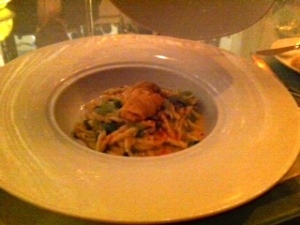
A fine pizza, from December 2013, when Provisions was my favorite restaurant in Houston. (Photo by James Brock)
I am sad today. You see, I once had a favorite restaurant in Houston, the restaurant to which I returned many times, so often that Angela refused, at some point, to ever go with me again. I, however, loved it. I have dined there perhaps 10 or 12 times, alone and with others. I have introduced a number of people to the place and its food. I have spent an evening at its “sister” restaurant, The Pass. Indeed, I have spent more time at Provisions than at any other restaurant in Houston. And all was good, at least for a few months.
Something has happened to Provisions, my go-to restaurant. I first noticed things were amiss about two months ago, when I ordered a pizza (Mushroom-Truffle Pizza/Black Trumpet Mushrooms, $18), which at the time was my favorite pizza in Houston. This pie, however, was soggy. I picked up the first slice and it was limp. It drooped down toward my plate, and when I bit into it the usually crisp crust was wet and sticky in my mouth. I asked a cook about it, and he told me they were having problems with the oven that night, something about maintaining proper temperature. Okay, I said, good to know, because I love that pizza.
The next week I was back, at the bar at the rear of the restaurant, a great little perch that seats two guests and affords a view of the kitchen and the dining room. I ordered the duck confit pizza. And again, limp crust, from the first piece. What was going on, I thought. The oven, which is very near my seat, looks impressive, and I know it can make great pies. But two in a row?
Until this past Thursday night, I had not been back to Provisions since the second poor pizza. I will estimate that a month or so had elapsed. I made plans to have dinner with a friend, and he recommended Provisions, then our party of two grew into a group of four, all good eaters whose palates I trust. Three of us arrived at about the same time, and while we awaited the fourth we shared a bottle of a very good South African red (AA Badenhorst, “Secateurs,” Coastal Region, 2010), a shiraz. And a good value at $36.

Roasted Shishito Peppers, most of which remained uneaten. (Photo by James Brock)
And here is where the sadness began to set in. We also shared some roasted shishito peppers. They are described thusly on the menu: Roasted Shishito Peppers/Cotija/Cilantro/Corn/Yuzukoshu. They cost $14. I love shishito peppers, had some really good ones at Caracol recently. But the peppers that night were barely roasted, and entirely devoid of salt, which we all agreed was needed. In fact, the best component of the dish was the onions. Where was the acid? Where was the delicious char?
Our fourth, Ms. S., arrived, and we ordered. I chose the sweetbreads (Crispy Veal Sweetbreads/Pickled Root Vegetables $18), because I eat sweetbreads as often as I find them. The other dishes? Lamb Merguez Pate en Croute/Yogurt/Cashew/Citrus $16; Broccoli Strozzapreti/Fennel Sausage/Tomato/Parmesan $13/22; and Uni Fettucini/Guanciale. All, in my opinion, mediocre at best. Seriously. Let me explain.
As I wrote, I love sweetbreads. But this dish, with one medium-sized sweetbread on it, was not good at all. The main problem: The sweetbread was overcooked. In fact, the exterior “crisp” of the breading obliterated any taste of the delicate organ. What I put in my mouth tasted as if it could have come from the fry basket at a fast-food joint. (The pickled vegetables were fine, and I enjoyed them. But the star of the plate was a waste of a sweetbread.)

It was a sin, to waste such a beautiful organ. (Photo by James Brock)
As I was making the first cut into the sweetbread, across the table one of my dining companions, Ms. B., was putting the first bite of the uni pasta into her mouth. Then this came out of her mouth: “Where is the uni?” There was absolutely no taste of the uni in the dish. All one detected, and it was not a bad taste at all, was the guanciale. She asked the waiter about the dish, and was told that the uni was used to prepare the pasta. She later said, forlornly, “I tried to pay attention to the taste of the noodles themselves, and did not get any earthy, uni ‘funk'”. We left it at that. I did not have the heart to tell her about the uni pasta I had earlier in Dallas this year at Spoon Bar & Kitchen, but here are a few photos of it. It was a very good bowl, and John Tesar has a great thing going there. I am already planning a return visit.


Spoon Bar & Kitchen’s uni with trofie (Photos by Surya Bhattacharya)
And the Broccoli Strozzapreti? It came to the table lukewarm at best, to begin. Ms. S. told the waiter that it was not warm enough, so he took it back. Meanwhile, Mr. R. was tucking into his Merguez en Croute, and he said he liked it, adding that perhaps it was a bit too salty. I tried a bite, and concurred. I also thought that it was a bit too dry.
At about that time we ordered another bottle of the Shiraz, and when the waiter brought it to the table he opened it and proceeded to pour from the bottle into my glass, which still contained an ample amount of wine from the previous bottle. We did not bother telling him that it might have been more proper for him to have brought a clean glass to the table so that we could taste the new bottle before he poured from it. Neither did we remind him that it would have been best to serve the women first.
We did not order dessert. The uni was not finished; the strozzapreti languished in the bowl. Ms. S.’s comment? Bland and overcooked pasta. My sweetbread was gone, as Mr. R. had taken a bite of it, agreeing with my assessment.
So, what is going on at Provisions? I don’t really have an answer. I am well aware that things can from time to time become chaotic. Even the best restaurant can, on occasion, send out a dish that is not as it should be. But two limp pizzas – after five or six perfect ones – and then a table full of mediocrity a month later? I am at a loss. And I write this as someone who has extolled the virtues of the food at Provisions, someone who has dined at The Pass and found it quite good. I am sad about the goings-on (at least as far as my past several experiences are concerned) at the restaurant that once was my favorite in Houston. And I so want to be happy again.
Like this:
Like Loading...



















































Recent Comments